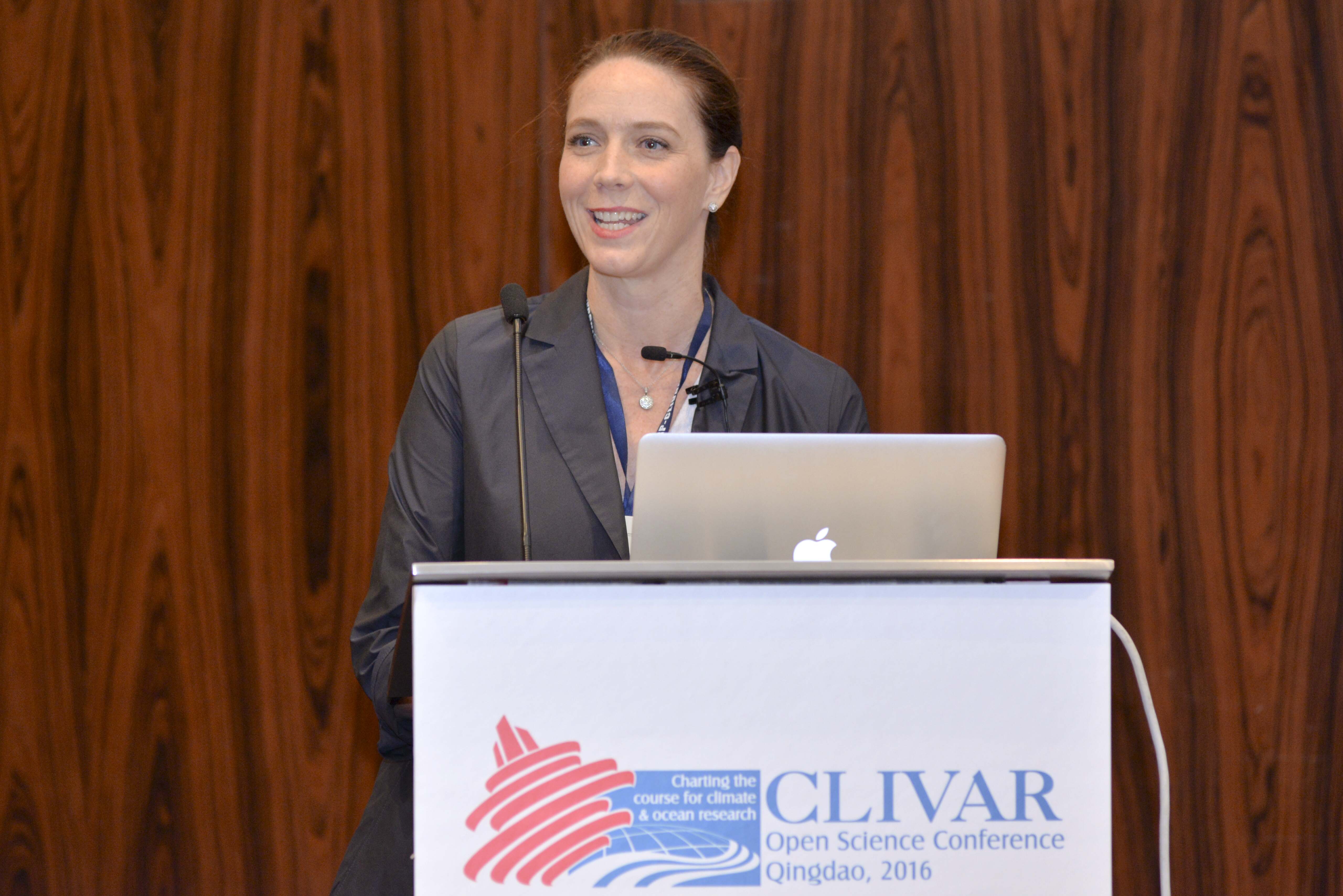CLIVAR OSC: Day 2 Highlights Climate Variability and Predictability

After an evening reception, held on the shores of the Yellow Sea, participants gathered the next morning for the second day of the conference under the theme of “Climate Variability and Predictability.” The main theme for the plenary talks, parallel sessions, and posters were split into the timeframes of intraseasonal to interannual, decadal, and centennial to millennial.
Opening the day was Harry Hendron, Australia Bureau of Meteorology, who talked about using coupled climate models to make subseasonal predictions for over 15 years and what progress has been made. Some of the more robust improvements include assimilation and initialization of systems, model development (such as the physics of clouds and convection) and resolution, ocean data coverage, and products. Yet he pointed out that regional climate predication has been more modest. Deployment of Argo has reduced analysis uncertainty, but as of yet there is little evidence of its impact on prediction.
Decadal variability can be examined in rainfall patterns, sea surface temperature, and the Atlantic Multidecadal Variability (AMV), for example, according to Rowan Sutton, National Centre for Atmospheric Sciences. It also has an influence on the risk of high-impact extreme events. Uncertainty in decadal climate projects is dominated by internal variability—climate response to greenhouse gases and uncertainties of forcing due to aerosols. In regards to the AMV, external forcing may serve as a pacemaker. And direct and indirect observations show a slowing of the Atlantic Meridional Overturning Circulation (AMOC) and heat transport.
Focusing on longer timescales, such as the historical past, Kim Cobb, Georgia Tech, turned attention to the question of “Is ENSO changing?” A tough question to answer due to the lack of data, but a great option exists in using paleo-ENSO records from corals that can reveal monthly resolution by using oxygen isotopes. One recent finding is that the 2015/16 El Niño event was anomalous when compared to the paleo record. Most of the pre-industrial data reflect a weaker ENSO than the present, as seen in multiple datasets. “Ultimately, though, there is still gross under sampling of a highly variable system,” Cobb said. She also encouraged the need for collaboration among the CLIVAR community with the paleo community to make progress on understanding the climate system.
Wrapping up the morning plenary was early career scientist, Yulia Polkova from the University of Hamburg, who presented on the predictive skill for regional interannual steric sea level and the mechanisms for predictability. What she showed is that seasonal to interannual predictability of sea level could be from 7 to 8 months and up to a year, but that there is a great deal of regional variability. There is correlation between observed sea level anomalies and wind-driven Rossby wave models. Initialized predications do show some skill in the Tropics and are very sensitive to initial conditions, which reveal some problems in the Atlantic.
After the parallel and poster sessions that took place during the day, participants gathered for a closing keynote lecture by Magdalena Balmaseda, European Center for Medium Range Weather Forecasts, on seamless prediction. “Seamless predication relies heavily on ocean observations,“ she stated right up front. The idea for seamless prediction comes from the need for reliable forecasts of meteorology at different timescales. One of the biggest requirements for improving this field is the air-sea coupled interaction. This is because a lack of coupling causes errors in tropical cyclone prediction, teleconnections of the Madden-Julian Oscillation are important, and improving representations of sea surface temperature in regions like the Gulf Stream will improve forecasts. Requirements to improve seamless prediction include working on scalable solutions in terms of computer and human resources, collaboration among multiple institutions, and a focus on emerging initiatives.
Below are some highlights from the parallel sessions.
Intraseasonal to interannual
- The existing and improving sources of predictability for the atmosphere and ocean include ENSO, the winter North Atlantic Oscillation (NAO), and cold air outbreaks, but there are untapped sources to explore such as on land and in the stratosphere.
- In regards to some mechanisms, tropical rainfall and heating seem to be a good predictor for the NAO, better than sea surface temperature, but there is still debate about the Pacific and Indian Ocean basins.
- The operational timescales of prediction include mostly interannual. The current challenges include the intraseaonal and multiyear.
- There are a number of tools providing services to end-users, such as the MISVA project (real-time Monitoring and forecast of IntraSeasonal Variability), which has good potential over Africa.
- Understanding the role of intraseaonal variability versus heat recharge is important for ENSO mechanisms and predictability. More research still needs to be done to understand diversity in the system, and using simpler models could be one way to advance the research to understand the role of easterly versus westerly wind events.
Decadal
- The Pacific Decadal Oscillation (PDO) is not a single phenomena but rather a statistical pattern resulting from the sum of several physical processes, such as North Pacific sea surface temperatures that integrate weather noise and ENSO forcing, a re-emergence that brings back anomalies in succeeding winters, and a more persistent Kuroshio Extension sea surface temperature anomalies that are driven by ocean dynamics.
- The UK Met Office decadal prediction system has applications to assess risk of unprecedented extreme events under the current climate in two regions: Southeast England and the Yangtze Basin. What was found is that some of the decadal prediction ensemble members do show observed record-braking wet events.
- To explain the observed link between the AMV and European climate in the summer, an east/west wave-like sea level pressure pattern has been identified, called the North Atlantic European East West mode. The mode influences European climate through temperature advection and by favoring an atmospheric blocking-like situation over Central to Eastern Europe.
- Using three different coupled models from NOAA GFDL and National Center for Atmospheric Research, researchers showed that the positive phase of the AMV leads to a warmer southern US and Mexico during the summer. This warming is due to an increase in incoming solar radiation and a decrease in latent heat fluxes.
- In the Southern Ocean, open ocean convection can trigger large decadal to multidecadal variability. Convection reduces sea-ice, increases the Drake Passage transport, and reduces the Ross Gyre strength.
- In a set of Community Earth System Model (CESM) simulations, the timescale of the AMOC variability differs considerably with dominant timescales of variability ranging from decadal to centennial. Nevertheless, there are some robust elements of AMOC variability mechanisms, like upper-ocean density and boundary layer anomalies preceding AMOC anomalies.
Centennial to millennial
- Simulations show a northern European storm track in the Last Glacial Maximum that is not seen in simulations (or observations) under present day conditions. At some point during deglaciation, the intensity of this new terrestrial storm track abruptly declines—meaning it weakens on a timescale much faster than the changing insolation.
- In coupled climate model simulations, changes in the height of the Northern Hemisphere ice sheets, particularly over North America, have the potential to impact the mid-latitude surface westerlies and trigger a sequence of cause and effect in the North Atlantic leading to a Dansgaard-Oeschger (DO) event.
The evening was filled with a variety of town halls, including and introduction to the Year of the Maritime Continent, ocean observing satellites, Indo-Pacific teleconnections, the WCRP Grand Challenge of melting ice, and an overview of Past Global Changes (PAGES) program.
Remember to follow #CLIVAR2016 for live updates from the conference.














Add new comment